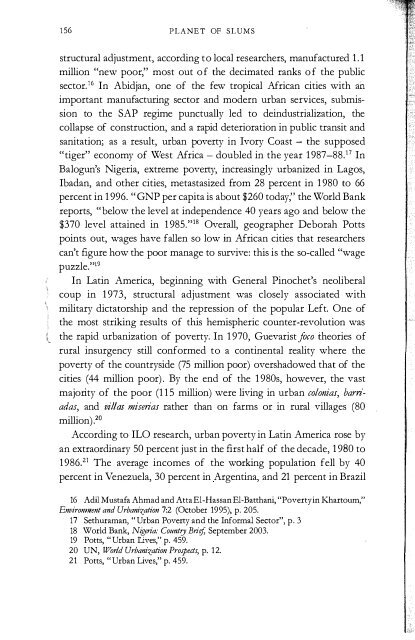Untitled - Rebel Studies Library
Untitled - Rebel Studies Library
Untitled - Rebel Studies Library
Create successful ePaper yourself
Turn your PDF publications into a flip-book with our unique Google optimized e-Paper software.
156 PLANET OF SLUMS<br />
structural adjustment, according to local researchers, manufactured 1.1<br />
million "new poor," most out of the decimated ranks of the public<br />
sector.16 In Abidjan, one of the few tropical African cities with an<br />
important manufacturing sector and modern urban services, submission<br />
to the SAP regime punctually led to deindustrialization, the<br />
collapse of construction, and a rapid deterioration in public transit and<br />
sanitation; as a result, urban poverty in Ivory Coast - the supposed<br />
"tiger" economy of West Africa - doubled in the year 1987-88.17 In<br />
Balogun's Nigeria, extreme poverty, increasingly urbanized in Lagos,<br />
Ibadan, and other cities, metastasized from 28 percent in 1980 to 66<br />
percent in 1996. "GNP per capita is about $260 today;' the World Bank<br />
reports, "below the level at independence 40 years ago and below the<br />
$370 level attained in 1985."18 Overall, geographer Deborah Potts<br />
points out, wages have fallen so low in African cities that researchers<br />
can't figure how the poor manage to survive: this is the so-called "wage<br />
puzzle."19<br />
In Latin America, beginning with General Pinochet's neoliberal<br />
coup in 1973, structural adjustment was closely associated with<br />
military dictatorship and the repression of the popular Left. One of<br />
the most striking results of this hemispheric counter-revolution was<br />
lc the rapid urbanization of poverty. In 1970, Guevarist flco theories of<br />
rural insurgency still conformed to a continental reality where the<br />
poverty of the countryside (75 million poor) overshadowed that of the<br />
cities (44 million poor) . By the end of the 1980s, however, the vast<br />
majority of the poor (1 15 million) were living in urban colonias, barn'adas,<br />
and villas miserias rather than on farms or in rural villages (80<br />
million) , zo<br />
According to ILO research, urban poverty in Latin America rose by<br />
an extraordinary 50 percent just in the first half of the decade, 1980 to<br />
1986.21 The average incomes of the working population fell by 40<br />
percent in Venezuela, 30 percent in Argentina, and 21 percent in Brazil<br />
16 Adil Mustafa Ahmad and Atta El-Hassan El-Batthani, "Poverty in Khartoum,"<br />
Environment and Urbanization 7:2 (October 1995), p. 205.<br />
17 Sethuraman, "Urban Poverty and the Informal Sector", p. 3<br />
18 World Bank, Nigeria: Country Brief, September 2003.<br />
19 Potts, "Urban Lives," p. 459.<br />
20 UN, World Urbanization Pro.rpects, p. 12.<br />
21 Potts, "Urban Lives," p. 459.<br />
SAPING THE THIRD \,{'ORLD 157<br />
and Costa Rica.22 In Mexico informal employment almost doubled<br />
between 1980 and 1987, while social expenditure fell to half its 1980<br />
leve1.23 In Peru the 1980s ended in an SAP-induced "hyper-recession"<br />
that cut formal employment from 60 to 11 percent of the urban workforce<br />
in three years and opened the doors of Lima's slums to the occult<br />
revolution of Sendero Luminoso.24<br />
Meanwhile, broad sections of the educated middle class, accustomed<br />
to live-in servants and European vacations, suddenly found<br />
themselves in the ranks of the new poor. In some cases, downward<br />
mobility was almost as abrupt as in Africa: the percentage of the urban<br />
population living in poverty, for example, increased by 5 percent in a<br />
single year (1980-81) in both Chile and Brazi1.25 But the same adjustments<br />
that crushed the poor and the public-sector middle class offered<br />
lucrative opportunities to privatizers, foreign importers, narcotrqfficantes,<br />
military brass, and political insiders. Conspicuous consumption reached<br />
hallucinatory levels in Latin America and Africa during the 1980s as the<br />
nouveaux riches went on spending sprees in Miami and Paris while their<br />
shantytown compatriots starved.<br />
Indices of inequality reached record heights in the 1980s. In Buenos<br />
Aires the richest decile's share of income increased from 10 times that<br />
of the poorest in 1984 to 23 times in 1989. In Rio de Janeiro, inequality<br />
as measured in classical GINI coefficients climbed from 0.58 in<br />
1981 to 0.67 in 1989,z6 Indeed, throughout Latin America, the 1980s<br />
deepened the canyons and elevated the peaks of the world's most<br />
'extreme social topography. According to a 2003 World Bank report,<br />
GINI coefficients are 10 points higher in Latin America than Asia;<br />
17.5 points higher than the OECD; and 2004 points higher than<br />
Eastern Europe. Even the most egalitarian country in Latin America,<br />
22 Alberto Minujin, "Squeezed: The Middle Class in Latin America," Environment<br />
and Urbanization 7:2 (October 1995), p. 155.<br />
23 Agustin Escobar and Mercedes Gonzalez de la Rocha, "Crisis, Restructuring<br />
and Urban Poverty in Mexico," Rmironment and Urbanization 7:1 (April 1995), pp. 63-64.<br />
24 Henry Dietz, Urban Poverty, Political Participation, and the State: Lima, 1970-1990,<br />
Pittsburgh 1998, pp. 58, 65.<br />
25 A. Oberai, Population Growth, Employment and Poverty in Third World Megaities,<br />
p. 85.<br />
26 Luis Ainstein, "Buenos Aires: A Case of Deepening Social Polarization," in<br />
Gilbert, The Mega-City in Latin America, p. 139.


